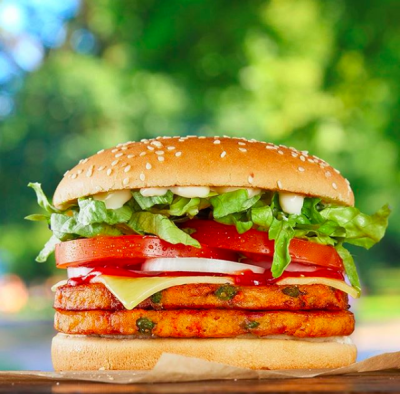As consumers, we often hear the term ‘humane slaughter’ used in connection with meat, egg, and dairy but the term ‘humane’ means ‘having or showing compassion or benevolence’. It is hard to see how that describes the deliberate taking of another’s life.
‘Humane slaughter’ is a marketing term—and an oxymoron—that provides a type of ‘psychological refuge’, which allows us to imagine the animal we are eating did not suffer during her final moments.
In a way, the growing need for meat, egg, and dairy producers to market themselves as ‘humane’ indicates a social shift in the way people view animals today. Empathy, experts say, is hard-wired into our genetics—and with the advent of social media and countless industry exposés, it’s harder and harder to deny the grim realities of animal agriculture.
Is there such a thing as humane slaughter?
Industry proponents generally describe ‘humane killing or slaughter’ as occurring when an animal is ‘rendered insensible until death ensues, without pain, suffering or distress.’ In theory, an animal will be stunned prior to bleeding out, so they are unconscious as they die.
However, we know that in practice that even this bleak minimum standard is not always met, with countless animals fully conscious as they have their throats slit, are shot in the head, are gassed, electrocuted, or worse. And even when stunning is provided, it often fails, requires multiple attempts and causes terrible suffering all of its own.
Former workers from slaughterhouses and factory farms have given haunting, real-life accounts of how this ‘humane slaughter’ process is anything but. Often, these ex-industry employees suffer from long-term psychological impacts resulting from continued exposure to extreme levels of violence, suffering, and death. Slaughterhouses make victims of people, too.
The very notion of ‘humane slaughter’ is intrinsically flawed, as it assumes that an animal does not value his or her life.
They Fight For Their Lives
As these workers will tell you, animals fight for their lives, right until their very last breath. They experience fear, pain, suffering, and loss, often beyond our worst imagination. Given the chance, they will also fight to protect their friends and their young.
In this way, ‘humane slaughter’ relies on the fallacy that animals are not conscious beings. But, of course, they are. Each has the capacity to have both positive and negative experiences, to feel joy, love and contentment, pain, fear and distress. As Animal Ethics remarks, “there are powerful reasons to conclude that this is what should matter when it comes to giving someone moral consideration and not discriminating against that being.”
An individual animal values their life just as much as you or I. And ultimately, there is no ‘humane’ way to kill someone who does not want to die.
WHAT ABOUT A HUMANE LIFE?
Another fatal flaw surrounding ‘humane slaughter’ is that the concept assumes a human’s only moral obligation is to provide an animal with a ‘quick’ death—but what of the conditions these animals endure during life?
US data suggests that over 99 percent of farmed animals spend their lives on Concentrated Animal Feeding Operations (CAFOs.) The horrific treatment of animals on such factory farms is well-documented, and happens in countries all over the world.
Factory-farmed chickens are kept in restrictive sheds, with little or no access to the outdoors. Most factory-farmed pigs are kept in ‘sow stalls’, or cages so small they can’t even turn around. Factory-farmed cows may spend time outdoors, but are still confined to feedlots without access to pasture or grass. Ducks are denied proper swimming water for the duration of their lives, which are always cut far too short.
There is nothing ‘humane’ about denying an animal access to the sun and the ground beneath their feet, or suppressing their natural behaviors. Breeding practices designed to maximize weight gain (or production of eggs and milk) also cause animals stress, ill health, and even premature death. As Game of Thrones actor Jerome Flynn said:
“[Animals’] lives are miserable from the moment they are born, until the day the lorries arrive to take them to slaughter. Yes, at the end of all this suffering, they are hauled off to the abattoir, where the sights and smells of blood and entrails are stomach-turning.”
Nothing humane happens in a slaughterhouse
The majority of people do not want to inflict harm on animals. In fact, a 2017 survey conducted by The Guardian found that 75 percent of American adults believe they usually eat meat, dairy, and eggs “from animals [who] are treated humanely”. A 2022 survey by VFC found that most consumers say they are animal lovers and oppose factory farming, but they did not know that almost all animals bred just to be slaughtered are kept this way.
Greenwashing
When we understand that ‘humane slaughter’ is little more than a marketing term, we can see that even consumers who care about animals’ welfare are likely to be contributing to their suffering. We’d urge everyone who cares about animals to take a look at what really happens on farms, and change what they can.
Factory farms and slaughterhouses only exist because of consumer demand. Instead of supporting inhumane practices, sign up to the Million Dollar Vegan challenge. By reducing or eliminating meat, eggs, and dairy from our plates, we can help end animal suffering, whilst enjoying new and delicious plant-based meal plans.
You’ll discover that a vegan diet is fun, tasty and—in the truest sense of the word—humane. Start your journey and download the Vegan Starter Kit today.



